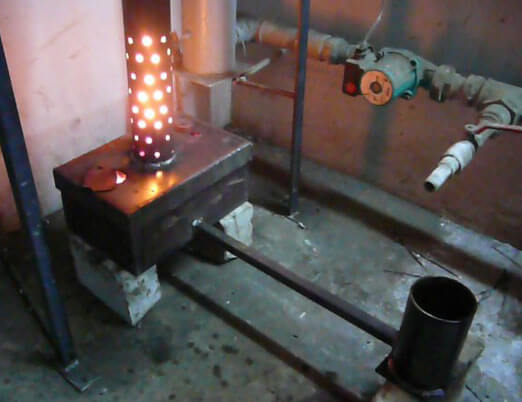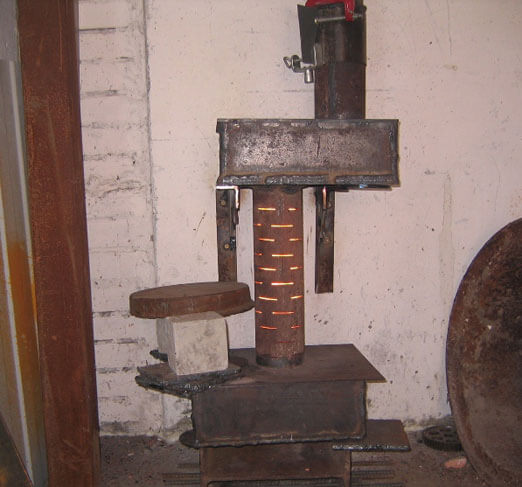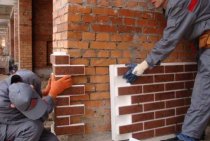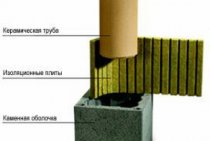The device of a home-made stove at work
Creating the simplest heating for working out with your own hands is quite simple. Waste oil heating furnace. consists of two containers that are connected by a pipe located between them. A structural element is also a chimney, which is designed to remove combustion products.
Containers are usually made of 4 mm metal, and 6 mm thick sheet metal is suitable for making the lid of the second container. The use of steel can significantly increase the service life of this structure, since too thin sheet metal will burn out very quickly.
The diameter of the pipe connecting the container must exceed 10 cm, and its length must exceed the thickness by at least 4 times. In the side of the pipe, it is necessary to drill 48 holes with a diameter of 9 mm. As practice shows, these holes are very well arranged in six rows, i.e. There are eight holes in each row.
The chimney pipe is made of fire-resistant steel and is located above the upper tank. The upper part of the pipe can be made from any material (tin, ceramics), because the gas, reaching the top of the chimney, cools down significantly. The height of the chimney usually ranges from four to seven meters.
To improve heat dissipation, it is worth using a chimney located at a slight angle, but the upper part should be located vertically so that the wind could not prevent the smoke from escaping. To protect against precipitation, you can install an umbrella or a visor on the pipe. When assembling a chimney, it is necessary to take into account the fact that in the future it will need to be regularly cleaned of settling elements, so it is best to make the chimney collapsible.
A connecting pipe is welded to the lid, to which, in turn, the upper container will be attached. The chimney is connected exactly to the upper tank in the place that was provided for this. The hole in the lid must be equipped with a damper, which, when the device is running, will affect the intensity of combustion. In addition, this damper allows you to reduce the amount of soot that is emitted from the chimney. The hole drilled in the lower tank will be used to fill in oil, ignite the stove and regulate draft.
The design is very simple, and such heating for working out with your own hands is built without much effort. The compact size and convenient shape make it possible to make such a stove "exit", which makes it possible to use it, for example, for heating a greenhouse in the country. Hot air exits through the holes drilled in the connecting pipe, and its temperature can reach 90-95 degrees Celsius. In addition, the heating of such a stove occurs quite quickly.
Operating rules
In order for the heating to work out to last a long time and not cause an accident, it is necessary to follow the basic rules of operation:
- Under no circumstances should used oil be exchanged for gasoline, acetone or other combustible substances.
- There should be no flammable substances near the functioning stove. Canisters of fuel located near the stove may explode if heated.
- If water enters the system, flames can be released, so care must be taken to ensure that the stove is dry.
- In case of fire, extinguish the stove with water in no case. To extinguish a fire, you can only use a fire extinguisher, which must be located in the room where the stove is installed.
- During operation of the stove, the ventilation must be open. If you block the access of clean air to the room, then after a while the concentration of carbon monoxide will become life-threatening.
Tools and materials
To make a boiler yourself, you will need:
- sheet steel with a thickness of 4 mm;
- metal pipe for air duct;
- 4 pieces of reinforcement with a cross section of 8 or 10 mm;
- compressor;
- pump;
- welding equipment;
- expansion tank;
- Bulgarian;
- asbestos cloth;
- half-inch corners, spurs and tees for the burner;
- steel adapters;
- heat resistant sealant.
The boiler can have any shape, therefore. If there is no sheet material of the required thickness, you can take a thick-walled pipe of large diameter or a cylinder of a suitable size. The simplest mining furnace is made from a pipe with a diameter of 50 cm, a pipe with a diameter of 20 cm, two round steel plates with a thickness of 3 mm or more. Despite the simplicity of design, such a stove does an excellent job of heating a garage of standard sizes.
The principle of operation of oil burners
The principle of operation of the oil burner is as follows: the fuel pumped from the fuel tank by the pump is mixed with air, the resulting mixture enters the nozzle, where it is burned. But taking into account the fact that fuel oil is a rather heavy and viscous substance that burns poorly under normal conditions, fuel oil burners have a number of design features. A heater is installed between the pump and the nozzle, bringing the temperature of the fuel to the required temperature for its atomization. Fuel consumption is controlled by a special regulator.
Advantages of Olympia oil burners
Olympia burners are modern high-tech devices that are well adapted to Russian boiler equipment and the operating conditions of our country. In addition, today they have the most affordable prices among other similar imported equipment.
Main advantages of Olympia oil burners:
- Compact design;
- Articulated heads are convenient to operate and easy to maintain;
- Automatic fuel spraying;
- Low noise level.
In LB oil burners, all processes are controlled by an electronic programmer.
Features of installation and operation of Olympia burners of the LB series
Oil burners of the LB series are complex technical devices, the installation, adjustment and maintenance of which must be carried out by specialists who have been trained by the company and have a license from the Russian Federation for this type of work.
The fuel oil used in automatic blast burners of this series must undergo appropriate purification from mechanical impurities.
GOST 10585-99 regulates the physical properties and mass fraction of impurities for fuel oil grades produced in the Russian Federation. In particular, in the most common grades M40 and M100, the percentage of impurities exceeds the permissible rate for its use with burners, which include Danfoss and SUNTEK gear fuel pumps. This also applies to the Olympia LB series burners. Moreover, in reality, mechanical impurities in fuel oil contain much more.
In addition, it should be taken into account that the torch formed during the combustion of fuel oil in blow-type burners is longer than during the combustion of other types of fuel. Therefore, it is necessary to select a burner that exactly matches the dimensions of the furnace.
Oil burners
Model range of oil burners
Instructions for oil burners "Olympia"
Passport of fuel pumps E4-6-7 for LB (fuel oil)
Nozzle table
Certificate of conformity for LB oil burner 1 part
Certificate of Conformity Oil Burner LB Part 2
Production of waste oil boilers
Boilers are more complex devices that can operate on waste oil. They can be assembled according to the drawings with your own hands. but for safety reasons, it is better to buy factory products. According to the principle of operation, this heating equipment is similar to boilers running on diesel fuel.
When designing a heating boiler, take into account the dimensions of the room that is planned to be heated using this equipment. The height of the ceilings also matters. If it is planned to organize, in addition to heating, also hot water supply, then double-circuit hot water boilers are installed, which also work on waste, recycled oil. It is also possible to use single-circuit boilers combined with a boiler for these purposes.
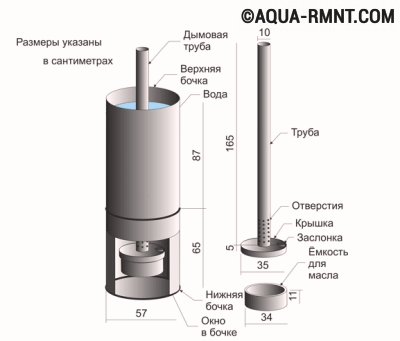
As you can see, you can organize heating on used oil with your own hands both with the help of home-made devices and with the help of factory models. The use of the latter guarantees the safety of their operation, since all technological requirements are observed during assembly.
The author so boldly suggests making a liquid fuel boiler himself that I wanted to object. Firstly, ready-made heating boilers are sold, designed to burn waste oil. These boilers can be installed at the same service stations and have free heating and hot water. They are safe and reliable in operation. Liquid fuel boilers are much more dangerous to operate than gas or solid fuel boilers. If oil spilled near the boiler catches fire, you can get such a smut that it won’t seem enough. Especially if several adjacent garages burn down along with cars.
I made a stove for testing according to the above scheme - the stove ignites and shoots with hot oil, it’s good that there were no consequences. put in the garage. The ceiling above the stove is black, a pancake killed so much time in vain. Yes, I added some work.
Site navigator
Burners for gas boilers.
There are two types of gas burners: - ejector and blast (fan). Blast gas burners, similar to diesel burners, are used in boilers with closed combustion chambers. Such burners can be equipped with fuel equipment and operate also depending on the conditions on liquid fuel. In addition to the step mode, some burner models operate in modulation mode, i.e. their power varies smoothly in a given range. Ejector burners, unlike blast burners, are built into the boiler furnace and are an integral part of it. The parameters of such burners depend on the design of the boiler heat exchanger and cannot be changed during operation. Ejector burners are quite simple and at the same time reliable in operation. The principle of operation is as follows: - when high-pressure combustible gas passes at high speed and pressure through a nozzle (tapering section), a rarefaction area is created in the mixing chamber, where primary atmospheric air rushes. The two streams are combined and a mixed stream is formed. Having passed the mixing chamber, the flow rushes into the diffuser, in which it slows down and the pressure increases. At the outlet of the ejector, the mixed flow is combined with the secondary air entering the boiler furnace, where it is burned. The simplest burner device consists of a nozzle spraying fuel, a mixing chamber, an igniter, a fuel valve that interrupts the fuel supply, and a flame control sensor. In a heating boiler, there can be from three to fifteen such burners. The fouling of the burner mixing chamber leads to a lack of primary air, which leads to combustion with a lack of oxygen, i.e. the burner begins to smoke and pollutes the combustion chamber with soot. Repairing the boiler with such a malfunction is quite complicated and includes disassembling the boiler, cleaning the furnace and burner. To prevent the development of such a situation, maintenance of the boiler should be carried out at least once a year.Ejector burners can also be stepped or modulated, however, a decrease in power, due to the design features, may adversely affect the stability of the flame. Also, the operation mode of the burner is affected by the amount of vacuum in the boiler furnace, which in turn depends on the parameters of the chimney. The main fuel of such burners is natural gas. When using liquefied gas, it is necessary, if there are no restrictions on the part of the manufacturer, to reconfigure the device for another type of fuel. In ejector burners for converting to LPG and vice versa, it is necessary to replace the nozzles on the fuel rail.
The design of blast gas burners is similar to diesel burners. Since the gas enters the burner under pressure, there is no need for a fuel pump. The air part of both burners is almost identical. The fuel supply is regulated by a gas solenoid valve controlled by a command from the combustion machine. To change the power of the burner, adjust the gas pressure at the burner nozzle and the position of the air damper. Additionally, the burner is equipped with an air and fuel pressure sensor.
Types of regulation of oil burners
The burners installed for oil-fired boilers differ in the number of stages - the way the power is adjusted. The main types of burners are:

- Single-stage - work takes place at one power, which is pre-configured taking into account the allowable range.
- Two-stage - during operation it is possible to use both 100% of power and 50%. The choice of the operating mode and the transition to it is made by the automation system, while it is possible to set modes with other indicators in the burner power range.
- Smooth two-stage - have two modes of operation at different capacities, but the transition occurs smoothly.
- Three-stage - work is carried out in three operating modes.
- Modulating - the burner power is adjusted smoothly depending on the temperature or pressure in the boiler, heat generator or furnace.
